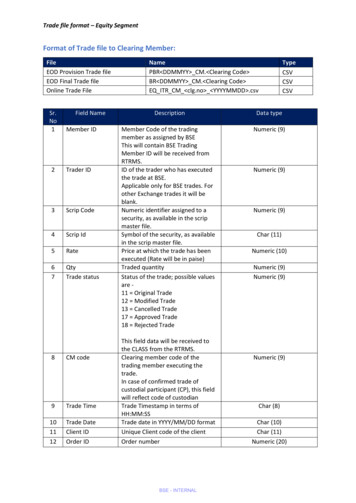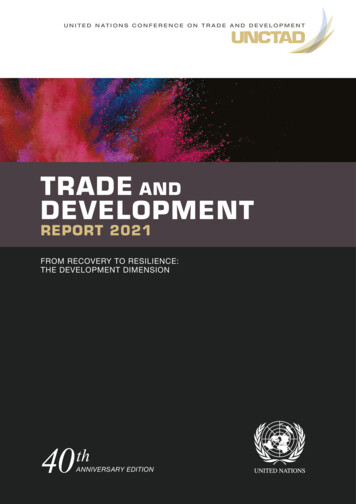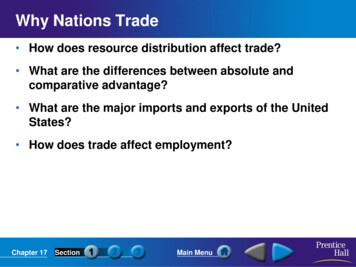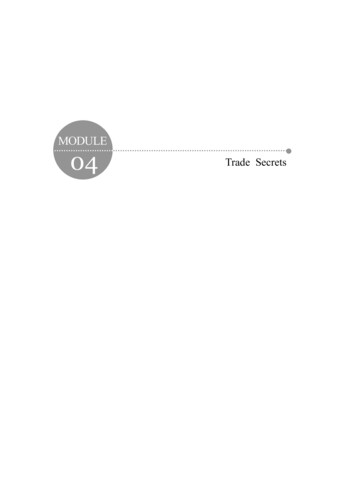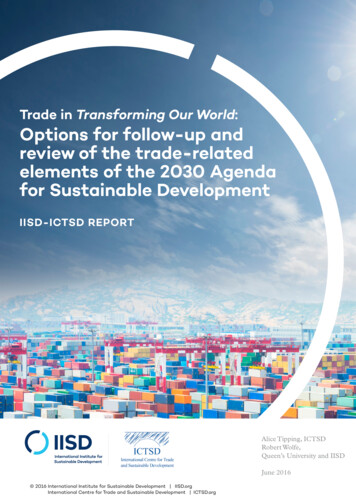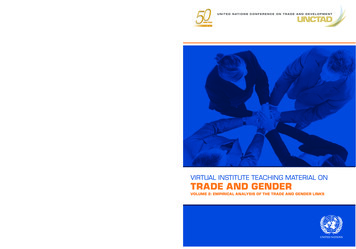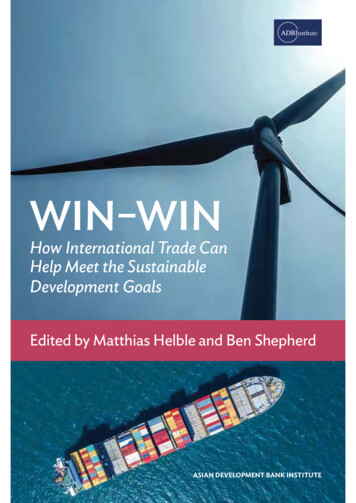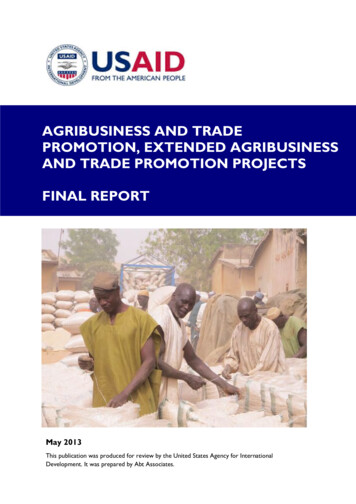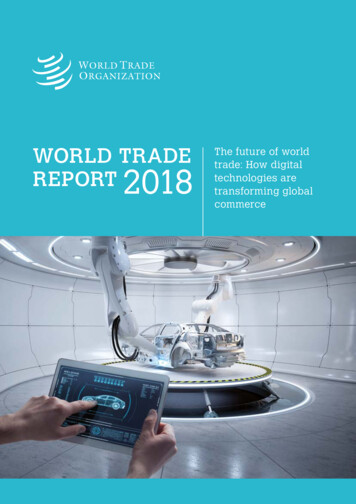
Transcription
T R A D E A N D D E V E L O P M E N T R E P O R T U P D AT EFrom the Great Lockdownto the Great Meltdown:Developing Country Debtin the Time of Covid-19EMBARGOThecontentofthisReportmustnotbe quoted or summarized in the print,broadcastorelectronicmediabefore23 April 2020, 15:00 GMT (17:00 Geneva).APRIL 2020U N I T E D N AT I O N S C O N F E R E N C E O N T R A D E A N D D E V E L O P M E N T
IntroductionThe Covid-19 shock is posing unprecedented challenges to advanced country governments. As mosthave come to recognize, the economic crisis entailed by the pandemic is unique in that it combines adeep supply shock - arising from wide-ranging and prolonged lockdowns of entire economies – withconsequent demand shocks – arising from a collapse in corporate investment plans, retrenchment ofhousehold spending, rapidly increasing unemployment and patchy social welfare systems reduced totheir bare bones after decades of rentier capitalism – as well as radical uncertainty and heightenedfragility in financial markets. As a consequence, policy makers have focused on the provision ofmassive stabilisation packages, designed to flatten both, the contagion curve of the pandemic as well asthe curve of economic meltdown and financial panic, through a raft of cash transfers, credit lines andguarantees from governments to households and firms. Doing so depends on the ability of governmentsto borrow from their central banks – or for central banks to revert to their original role as bankers totheir governments1 – on the required scale, a concept often referred to as ‘fiscal space’. How to dealwith this necessary accumulation of government debt in response to the crisis, and in particular, how toavoid the mistake of turning to austerity to make adjustments once the crisis has passed, is alreadybeginning to tax the minds of policymakers in the advanced economies.2If the challenges are huge in advanced economies, they are enormously more daunting in developingeconomies. While advanced country governments struggle to revamp administrative and regulatoryframeworks and to break ideological taboos, developing countries cannot easily flatten the contagioncurve by closing down their largely informal economies without facing the prospect of more peopledying from starvation than from the Covid-19 illness. Moreover, even the most advanced high-incomedeveloping countries with relatively deep financial and banking systems do not have anywhere near thefiscal space that advanced economies can, in principle, unlock.The vast majority of developing countries are heavily reliant on access to the ‘hard currencies’ ofadvanced countries – earned primarily through commodity and service exports, such as food, oil andtourism, and received through remittances from their diasporas as well as from access to concessionaland market-based borrowing –to pay for imports and to meet external debt obligations. Their centralbanks cannot act as lenders of last resort to their governments at the required scale without riskingcatastrophic depreciations of their local against hard currencies, and therefore also steep increases inthe value of their foreign-currency denominated debt as well as unleashing, potentially, destructiveinflationary pressures.This situation is all the more critical where developing countries already face high debt burdens.The Covid-19 shock has put a glaring spotlight on the difficulties arising from high and risingdeveloping country indebtedness since it is set to turn what was already a dire situation into serialsovereign defaults across the developing world. It has, therefore, turbo charged the need to move fromdiscussion to action on debt matters in developing countries.Following a brief discussion of current debt vulnerabilities in developing countries, this update ofUNCTAD’s Trade and Development Report 2019 lays out a series of steps that the internationalcommunity will need to take if there is to be any hope of salvaging the Agenda 2030 and moving to amore resilient and sustainable future for all countries.1See S Kapoor and W. Buiter (2020) To fight the COVID pandemic, policymakers must move fast and break taboos, Vox Cepr PolicyPortal, 6th April.2 See Emma Dawson (2020) We do not have to worry about paying off the coronavirus debt for generations, The Guardian, 22nd April.UNCTADFrom the Great Lockdown to the Great Meltdown:Developing Country Debt in the Time of Covid-192
Developing country debt pre-Covid-19: Rising vulnerabilities and a loomingwall of debt repaymentsCovid-19 hits developing economies at a time when they had already been struggling with unsustainabledebt burdens for many years.Figure 1Total Debt Stocks, all developing countries, 1960–2018(Percentage of GDP)2001801601401201008060402001960 1964 1968 1972 1976 1980 1984 1988 1992 1996 2000 2004 2008 2012 2016Public Debt (% GDP)Private Debt (% GDP)Source: UNCTAD secretariat calculations based on IMF Global Debt Database.As Figure 1 shows, at end-20183 the total debt stocks of developing countries – external and domestic,private and public – stood at 191 per cent (or almost double) their combined GDP, the highest level onrecord. A developing country debt crisis, already under way prior to the Covid-19 shock, had manyfacets4, but two are worthwhile putting upfront in the context of ongoing debates about debt relief forthe developing world in the aftermath of the Covid-19 shock. First, the unfolding debt crisis was notlimited to the poorest of developing countries but affected developing economies of all incomecategories.5 Second, it has, by and large, not been caused by economic mismanagement at home, but byeconomic and financial mismanagement at the global level. Over the past decade, developing countrieshave witnessed a rapid and often premature integration into heavily underregulated internationalfinancial markets, including the so-called shadow-banking sectors, estimated to be in control of aroundhalf of the world’s financial assets. 6In this context, developing countries became highly vulnerable to massive but volatile flows of highrisk yet relatively cheap short-term private credit, on offer from financial speculators in search of higheryields on their investments than available to them in the near-zero interest monetary policy environment3Last date for which this data is available at present.For more detail, see UNCTAD Trade and Development Report 2019: Financing a Global Green New Deal, chapter IV: Making debt workfor development. UN Publication, Geneva.5 See e.g. M. A. Kose, P. Nagle, F. Ohnsorge and N. Sugawara 2020. Global Waves of Debt. Causes and Consequences. World BankGroup. Washington DC, p. 12.6 Financial Stability Report (2019). Global Monitoring Report on non-Bank financial intermediation 2018, February.4UNCTADFrom the Great Lockdown to the Great Meltdown:Developing Country Debt in the Time of Covid-193
of their advanced home countries. This ‘push factor’, and the volatility of private capital inflows incombination with wide open capital accounts, has affected developing countries whether or not theyhad so-called strong economic fundamentals, such as relatively low public debt, small budget deficits,low inflation rates and high reserve holdings.7 An essential ‘pull factor’ leading developing countriesto borrow at high risk in international financial markets was their dwindling access to concessionalmultilateral finance and a shift of Official Development Assistance (ODA) away from central budgetsupport towards wider goals, such as climate change mitigation, migration management, goodgovernance and post-conflict support, oftentimes determined by donor interests.As a result, developing countries have seen a rapid build-up in private sector indebtedness, in particularsince the Global Financial Crisis of 2008-09, accounting for 139 per cent of their combined GDP atend-2018 (see Figure 1). This trend has been most pronounced in high-income developing countrieswith relatively deeper domestic financial and banking sectors but has also and substantively affectedmiddle- and low-income developing economies. It represents the largest contingent liability on publicbalance sheet in the event of a full-blown debt and financial crisis, not least in the shape of fledglingpublic-private partnerships, widely promoted throughout the developing world, but that may nowquickly unravel in the wake of ‘sudden stops’ to their refinancing due to the Covid-19 crisis.The fragility of developing country debt positions prior to the Covid-19 crisis was further increased byconcomitant changes to the ownership and currency-denomination of their private and public debt.Thus, domestic bond markets were increasingly penetrated by non-resident investors and sovereignexternal debt held to a much larger extent than in previous episodes of developing country debt distressby private rather than official creditors, in particular in high- and middle-income developing economies(see Figure 2).Figure 2Long-term public and publicly guaranteed external (PPG) debt bycreditor, all developing countries, debt stocks at end 2018(Billions of current US dollars)Source: UNCTAD secretariat calculations based on World Bank International Debt Statistics.7See e.g. Eichengreen, B. et al. 2017. Are capital flows fickle? Increasingly? And does the answer still depend on type? World BankGroup Policy Research Working Paper 7972. February. Washington DC.; Eichengreen, B. and P. Gupta. 2016. Managing Sudden Stops.World Bank Group Policy Research Working Paper 7639. April. Washington DC.UNCTADFrom the Great Lockdown to the Great Meltdown:Developing Country Debt in the Time of Covid-194
In the wake of these developments, much of the higher-risk borrowing by sovereigns has beenaccompanied by rising debt servicing costs with a negative impact on the fiscal space of many countries,compounded by a slowdown in growth relative to the period before the Global Financial Crisis of 200809 as well as by commodity price slumps.Figure 3Ratio of debt service on long-term public and publicly guaranteedexternal debt to government revenues, 2000, 2012 and 2018(in logarithm)Number of developing and transitioneconomies (N 121)3025Year 2018Year 201220Year -0.200.20.40.60.811.21.41.61.8Debt Service to Government Revenues (in Logarithm)Source: UNCTAD secretariat calculations based on World Development Indicators (WDI), IMF World Economic Outlook(WEO), Economic Intelligence Unit database (EUI) and World Bank Quarterly External Debt Statistics (QEDS).Figure 3 depicts the distribution of debt service burdens, as a share of government revenues, acrossdeveloping countries in 2000, 2012 and 2018. While these had declined substantively between 2000and 2012 (as indicated by the leftward shift of the distributions for 2000 to those for 2012 and by thefall in the distributions’ median value depicted by the green arrow), this progress has largely beenreversed since then (as indicated by the rightward shift of the distributions for 2012 to those of 2018and the by increase in these distributions’ median value depicted by the red arrow). Thus, servicingtheir external long-term public and publicly guaranteed debt cost developing country governments onaverage 6.5 per cent of their government revenues in 2012, but 10.3 per cent in 2018.UNCTADFrom the Great Lockdown to the Great Meltdown:Developing Country Debt in the Time of Covid-195
Figure 4Ratio of debt service on long-term public and publicly guaranteedexternal debt to government revenues, top 20 developing andtransition economies in 2018 (%)010203040506070DjiboutiVenezuela (Bolivarian Rep. of)LebanonSri LankaAngolaMontenegroGhanaCosta RicaLao People's Dem. thiopiaEl SalvadorTunisiaAlbaniaDominican Republic20182012Source: UNCTAD secretariat calculations based on World Development Indicators (WDI) and IMF World Economic Outlook(WEO).However, the situation is much more severe in many developing countries where more than a quarterof revenues are absorbed by debt servicing (Figure 4). This includes a number of oil exporters, facinga particularly difficult moment given the collapse in oil prices, as well as middle-income economiesthat have witnessed a sharp outflow of portfolio capital since the start of the crisis (Figure 5).Figure 5Cumulative net non-resident portfolio capital outflows fromselected developing countries, 24 January to 17 April,(Billions of current US dollars)20-2-4-6-8-10-12-14-16-18-20TurkeySouth AfricaThailandMexicoBrazilIndonesiaIndiaJan 2020Feb 2020March 202017 April 2020Source: UNCTAD secretariat calculations based on IIF Daily Emerging Market Portfolio database.Note: Data for Brazil includes equity flows only; and for Mexico and Turkey debt flows only.UNCTADFrom the Great Lockdown to the Great Meltdown:Developing Country Debt in the Time of Covid-196
Predictably, developing countries will be facing a wall of debt service repayments throughout the 2020s,and in the context of deeply distressed economic circumstances. In 2020 and 2021 alone, these amountto between 2 to 2.3 trillion in high-income developing countries, and to between 700 billion to 1.1 trillion in middle-and low-income countries (see Figure 6).8Figure 6Redemption schedules for public external debt, all developingcountries, 2020 and 2021(Trillions of current US dollars)2.5USD Trillions21.510.50High-income Developing CountriesHigh estimateMiddle- and low-income developingcountriesLow estimateSource: UNCTAD secretariat calculations based on World Bank QEDS and World Development Indicators , IIF Global DebtMonitor and IMF Global Debt Database.Note: Data refer to sovereign debt for HICs and to public external debt for MICs and LICs.Charlie Brown goes to Washington: 9 The promise of relieving developingcountries’ debt burdens in response to the Covid-19 shock On 13 April, the IMF cancelled debt repayments due to it by the 25 poorest developing economies forthe next six months. This debt cancellation is estimated to amount to around 215 million.10 Moreover,on 15 April, G20 leaders announced their “Debt Service Suspension Initiative for Poorest Countries”.11This suspension of debt service payments (including principals and interest) from 01 May to the end of2020 applies to 73 primarily low-income developing countries that are either eligible to borrow fromthe International Development Association (IDA) or are classified as least developed countries (LDCs)by the United Nations (UN LDCs).12 For now, the initiative applies to all official bilateral creditors,with calls on private creditors to join on comparable terms, and on multilateral banks to consider joiningshould such a step be compatible with maintaining their current high credit ratings and low-cost lendingcapacities. Qualifying developing countries must make a formal request for forbearance to their creditor8The range estimates for redemption schedules for public external debt in 2020 and 2021 for all developing countries results from thecombination of observed redemptions schedules for 44 developing countries, including major developing economies, and estimatedredemptions for all others, considering their income group. Developing countries, especially within the same income group, show somedegree of synchronization in their external debt redemption schedules, which is mostly shaped by the financial conditions prevailing ininternational financial markets. This explains why, as a whole, they periodically face “walls of maturity”: the bonds and the loans that theycontract in international markets often come to maturity in the same time period. The estimation therefore consists in applying thedistribution of redemption schedules relatively to public debt stocks from the 44 observed countries. The low and high estimates refer tothe lower and higher bounds of the distribution, respectively, defined as the 10th and 90th percentiles.9 Recalling one of the cartoon character Charlie Browns’ best known comments “I have been repeating the same mistakes in life for solong now I may as well call them traditions”10 See e.g. to-215-million-of-debt-cancellation-by-imf11 G20 Finance Ministers and Central Bank Governors Meeting. Communiqué. 15 April 2020. Annex II, p. 12-13.12 Of the 76 IDA-eligible developing countries, 4 (Eritrea, Sudan, Syria and Zimbabwe) are excluded due to protracted non-accrual status.Of the UN LDCs, only Angola is not also an IDA-eligible country and therefore included.UNCTADFrom the Great Lockdown to the Great Meltdown:Developing Country Debt in the Time of Covid-197
countries and their eligibility for the initiative is conditional on a number of factors, including an activeborrowing status with the IMF (or a request for financing from the IMF), the use of the temporarilyfreed-up resources for increased health and economic spending in response to the Covid-19 crisis, andfull disclosure of all public sector debt obligations (with the exception of commercially sensitiveinformation).Current estimates suggest that this initiative covers around 20 billion of public debt owed to officialbilateral creditors in the eligible countries in 2020. An additional 8 billions of such debt paymentsmight be included, if all private creditors joined the initiative, and a further 12 billion if the same wasthe case for all multilateral creditors13 However, this amounts to a relatively small part of the long termpublic and publicly guaranteed external debt stocks these countries had accumulated at the end of 2018,as Figure 7 shows.Figure 7Long-term public and publicly guaranteed external (PPG) debt by creditorin developing countries benefiting from the G20 debt service paymentsuspension initiative, 2018(Billions of current US dollars)Source: See Figure 2 above.Initiatives such as these are welcome since they provide urgently needed fiscal “breathing space” tocrisis-ridden developing countries, but they do not constitute debt relief of any kind. Quite the contrary,by linking eligibility to new or ongoing borrowing, even if on concessional terms, the initiativeprioritizes concessional lending (and therefore new debt) over debt relief. Moreover, suspending debtrepayments only through the end of 2020 relies on the all but heroic assumption that the Covid-19 shockto developing economies will be swift and short, and “business as usual” will resume in 2021 to theextent that developing countries joining the scheme will be in a position to shoulder debt servicerepayments suspended in 2020 over the next three to four years. But given the wall of debt servicerepayments already facing many developing country governments in 2021 (see Figure 6) and beyond,in combination with the wider macroeconomic impacts of the Covid-19 crisis on export revenues,commodity prices, government revenues and reserve holdings, as well as new concessional borrowingincurred during the crisis, this is unlikely to be the case. And of course – with few exceptions such asNigeria, Ghana, Pakistan and some Small Island Developing States – middle- and high-income13See e.g. om the Great Lockdown to the Great Meltdown:Developing Country Debt in the Time of Covid-198
developing countries are excluded, despite many of these economies facing unsustainable debt burdensand potential financial meltdowns. . and what needs to be done: Time for a “Global Debt Deal” for thedeveloping worldIn the wake of the Covid-19 crisis, developing countries will require massive liquidity and financingsupport to deal with the immediate fall-out from the pandemic and its economic repercussions. As bothUNCTAD and the IMF have estimated, these liquidity and financing needs amount to at least 2.5trillion. Clearly, debt relief measures will cover only a part of these needs, with new allocations ofSpecial Drawing Rights and a grant-based ODA Marshall Plan to support health and social expendituresproviding faster avenues to deliver urgently needed cash injections. Both the IMF and the World Bankalso announced enhanced lending facilities for developing country members to help deal with the crisis.The IMF has increased access limits to its Rapid Credit Facility, for now until October 2020, from 50to 100 per cent of annual country SDR quotas and to 150 per cent on a cumulative basis. Together withits Rapid Financing Instrument, the Fund’s emergency financing is expected to amount to around 100billion. The World Bank has put in place a 14 billion fast-track package to respond to immediate healthand economic needs and envisages to use around 160 billion in longer-term financial support over thenext 15 months. However, these are debt-creating financing instruments and though involving fewerconditionalities and a faster approval process, in the case of the Fund, eligibility still depends on familiar(and arguably under current conditions highly restrictive) criteria, including, inter alia, the country’sdebt being sustainable or on track to be sustainable, and that it is pursuing appropriate policies to addressthe crisis. 14Well-designed debt relief – through a combination of temporary standstills with sovereign debtreprofiling and restructuring – is essential in that it addresses not only immediate liquidity pressures buthas the potential to resolve problems of structural insolvency and long-term debt sustainability. As hasbeen pointed out, the Covid-19 shock only puts the spotlight on what had already been a fast-evolvingsovereign debt crisis across the developing world. The devastation it is likely to cause unless decisiveaction is taken, should be more than sufficient motivation for the international community to finallymove towards a coherent and comprehensive framework to deal with unsustainable sovereign debt.Basic lessons from the pre-Covid-19 system of sovereign debt relief and restructuringDebt relief mechanisms for developing countries, emerging gradually with the advent of recurrent andwidespread developing country debt crises since the end of the 1970s, have been fragmented, ad hocand insufficient to prevent sovereign debt crises or to resolve such crises sustainably, once theseoccurred (Box 1). In practice, the pre-Covid-19 ‘non-system’ to deal with potentially unsustainable debtpositions suffers from a series of flaws and weaknesses which hamper the debtor economy’s ability torecover and impose undue social, political and economic adjustment costs:§Too little too late: An early determination of whether a country is facing a liquidity or solvencycrisis is essential for the orderly management of a debt problem. Under the current system,neither debtor governments (who fear a self-fulfilling crisis and reputational risk) nor creditors(who fear taking undue losses) have an incentive to recognize a situation of over-indebtedness14On the limits of the 1 trillion of available funding in total from the IMF see D. Lubin, The IMF’s 1 trillion lending power is not all it iscracked up to be, Finacial Times, 21stApril.UNCTADFrom the Great Lockdown to the Great Meltdown:Developing Country Debt in the Time of Covid-199
and take early and comprehensive action. Overly optimistic forecasts about debt sustainabilityby international financial institutions accompanying emergency support only add to the delay.Thus, recent research shows that since 1970 49.7 per cent of sovereign restructuring episodeswith private creditors have been followed by another default within a time window of three toseven years, and 60 per cent were followed by further restructuring. 15§Lopsided resolution: Unlike private firms, indebted States cannot go bankrupt. But theeconomic recovery needed to repair the government balance sheet requires a supportiveinternational framework that allows the debtor country to conduct countercyclical policieswhich will enable it to restore its debt servicing capacity through investment, output and exportgrowth, rather than income, expenditure and import contraction. The current internationalfinancial and monetary system, however, favours the latter. This is evidenced by the IMF’s“stand-by agreements” (SBAs) under which – even after some relaxation of conditionalities –access to associated credits typically include the requirement for fiscal and monetary austeritymeasures.§Non-cooperative creditors: The shift from bank lending to bond financing has coincided witha general strengthening of creditor rights. This has provided new opportunities for vulture fundsto buy defaulted bonds and aggressively pursue litigation procedures through the courts. Suchactions have been particularly disruptive in the context of multilateral debt relief efforts. Theyhave also highlighted the conflict between a purely private-law paradigm that seeks to enforcecontracts at any cost and the logic of public law which is supposed to consider the widereconomic and social consequences of legal actions. Courts have generally endorsed holdouts’views, even at the expense of sovereign debt sustainability and the interests not only of thedebtor country, but also of bondholders willing to reach a viable agreement.A new ‘Global Debt Deal’ for developing countriesArgentina’s recent approach to its negotiations with its private and multilateral external creditors setsout some basic principles required to overcome these shortcomings (Box 2).16 A new “global debt deal”for developing countries should take note of these principles and, more generally, incorporate thefollowing three basic steps.17Step 1: Automatic temporary standstills: Longer and more comprehensiveThe purpose of temporary standstills is to provide macroeconomic “breathing space” for crisis-strickendeveloping countries to free up resources, normally dedicated to service in particular external sovereigndebt, for two interrelated uses: First, to facilitate an effective response to the Covid-19 shock throughincreased health and social expenditure in the immediate future and, second, to allow for post-crisiseconomic recovery along sustainable growth, fiscal and trade balance trajectories.An effective ‘Global Debt Deal’ for the developing world should therefore allow for automatictemporary standstills15Guzman M. Sovereign debt crisis resolution: will this time be different? Presentation held at the 12th UNCTAD Debt ManagementConference, November 2019.16 For a wider discussion of the principles required to guide sovereign debt restructuring, see UNCTAD, Trade and Development Report2015, chapter IV, and the Yale Journal of International Law, Special Issue on Sovereign Debt, Fall 2016, Vol 41, number 2.17 See also United Nations (2020), Debt and Covid-19: A Global Response in Solidarity, April 17, New York.UNCTADFrom the Great Lockdown to the Great Meltdown:Developing Country Debt in the Time of Covid-1910
§on request by developing country governments for forbearance, independently of their percapita income levels or other eligibility criteria or conditionalities, for an initial suspensionperiod of one year from request, and with the possibility of further annual renewals based onrecent debt sustainability assessments (see step 2 below).§on a comprehensive basis, including all external creditors – bilateral, private and multilateral– primarily to safeguard against resources freed up by the suspension of debt servicerepayments to some creditors being used to meet repayment schedules of un-cooperativecreditors§entailing an immediate and automatic stay on all creditor enforcement actions. Creditorsshould not be able to seize assets or initiate court proceedings against any sovereign creditorthat fails to make debt service payments during the pandemic. In addition, authorities in thosejurisdictions that govern most emerging market sovereign bonds should cooperate by haltinglawsuits against debtor countries already under way at the time of a temporary standstillarrangement coming into force.Step 2: Debt relief and restructuring programmes: Restoring long-term debtsustainabilityThe “breathing space” gained under step 1 should be used to reassess longer-term developing countrydebt sustainability, on a case-by-case basis, based on the following key principles:§The size and composition of debt relief or “haircuts”, if required, as well as the new redemptionschedules for debt repayment on restructured sovereign debt obligations following resumptionof debt service repayments, should be compatible with restoring and maintaining sustainableand inclusive growth paths, as well as fiscal and trade balance trajectories.§Long-term sovereign debt sustainability assessments, and consequent restructurings whererequired, should take account of contingent liabilities, such as those arising from wide-spreadpublic guarantees of new financing instruments and public-private partnerships.§Sovereign debt restructurings and revised debt payment redemptions schedules shouldfurthermore take account of investment requirements arising from the Sustainable DevelopmentGoals and the timely implementation of Agenda 2030.§There must be a fair distribution of the burdens of required sovereign debt relief andrestructurings between debtors and creditors, taking into consideration past histories ofirresponsible lending by creditors as well as irresponsible borrowing by debtors, as appropriate.§Respect for national sovereignty and expertise as well as national development strategiesTaking the successful outcome of the 1953 London Conference on German war debt, which cancelledaround half of this debt under negotiation (see Box 1), as a benchmark of international solidarity, atarget figure of around a trillion US dollars would appear reasonable in light of the debt burdens nowcrushing developing countries in the face of Covid-19.UNCTADFrom the Great Lockdown to the Great Meltdown:Developing Country Debt in the T
UNCTAD Developing Country Debt in the Time of Covid-19 From the Great Lockdown to the Great Meltdown: 4 of their advanced home countries. This 'push factor', and the volatility of private capital inflows in combination with wide open capital accounts, has affected developing countries whether or not they had so-called strong economic fundamentals, such as relatively low public debt, small .
